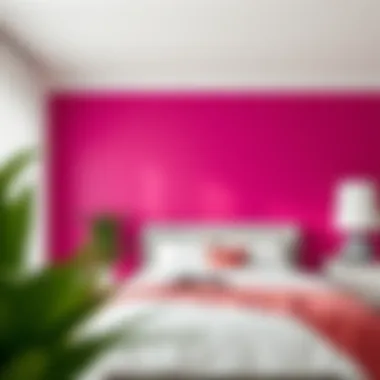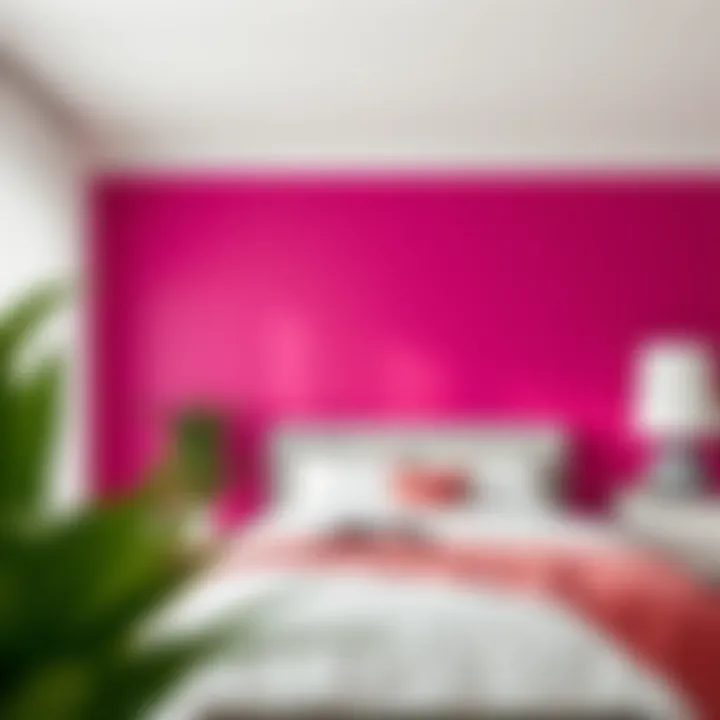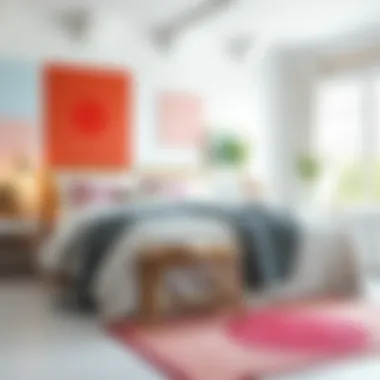Infusing Color into White Bedrooms: Design Strategies


Intro
In a world where personal taste reigns supreme, the aesthetics of one's living space can significantly influence mood and overall well-being. White bedrooms have gained popularity for their clean, crisp looks and calming atmosphere. While they certainly have their charm, many homeowners desire a burst of color to express individuality and vibrancy. The key is not to strip away the tranquility that whites offer. Instead, it's about harmoniously blending colors into these sanctuaries while preserving their serene essence.
This article delves into the multifaceted approaches to refreshing white bedrooms with lively hues. It explores design principles, colorful palettes, and practical strategies to cultivate a personal aesthetic that reflects individual flair. Whether you're an interior design enthusiast or simply seeking to liven up your space, discovering how to incorporate color effectively can transform your bedroom into a unique oasis.
Let's embark on this journey of color infusion and draw inspiration from the endless possibilities of design!
Design Inspirations
Vibrant colors can breathe life into the most muted spaces. When considering how to enhance a white bedroom, it's essential to look at different design inspirations that not only embrace color but also elevate the overall ambiance of the space.
Trending Styles
In recent times, several interior design trends have emerged that utilize color in innovative ways. Here are a few noteworthy styles to inspire:
- Scandinavian Minimalism: This trend emphasizes simplicity and functionality while embracing subtle color accents. Light woods and soft pastels often accompany white walls, bringing warmth without overwhelming the senses.
- Bohemian Allure: Encompassing a more eclectic mix, the Boho style incorporates rich jewel tones like deep purples and emerald greens, alongside patterned textiles. Potted plants and art pieces can further add character.
- Modern Vintage: This style blends contemporary elements with vintage finds. Think pastel colors on mid-century furniture, paired with bold abstract art to create a balanced visual narrative.
These styles show that even a predominant white color scheme can welcome and complement diverse colors through careful selection and placement.
Color Palettes
Choosing the right color palette is paramount in transforming a white bedroom. Here are a few to consider:
- Monochromatic Magic: Various shades of a single color can create depth. For instance, using navy blue in different tones can provide a soothing yet sophisticated effect when paired with white walls.
- Accent Wonders: Select a few vibrant colors to serve as accents throughout the room. A bright yellow bedspread or teal throw pillows can break the dominance of white without overpowering it.
- Natural Hues: Earthy tones such as greens, browns, and terracotta offer an organic touch that works beautifully against white. These colors can evoke a calming atmosphere reminiscent of nature.
“Color is a power which directly influences the soul.” - Wassily Kandinsky
The goal is to select colors that resonate with personal taste while also fitting the room’s purpose. For instance, soothing blues may work well in a bedroom meant for relaxation.
Maintenance and Upkeep
Adding color doesn’t mean letting go of maintenance. Keeping a vibrant bedroom fresh and tidy involves a few considerations.
Seasonal Maintenance Checklist
Taking care of a white bedroom with added colors requires keeping up with basic maintenance tasks:
- Spring: Dust surfaces, wash mirrors and windows, and touch up any paint that might have faded.
- Summer: Rotate bedding and pillows to blend seasonal colors; clean fans and air-conditioning filters.
- Fall: Ensure that your colorful accessories are ready for cozy, warm nights. Replace faded pillows or throws.
- Winter: Layer your bedding to add warmth, and consider deep cleaning carpets and upholstery to maintain freshness.
Cleaning and Organization Tips
Colors can attract dust, so regular cleaning is essential:
- Use gentle cleaning solutions that won't harm fabrics. A damp cloth works wonders on colored furniture.
- Organize items in bins or baskets that complement your color scheme, creating harmony in the space.
- Regularly reassess your color accents; sometimes a quick swap of pillows and throws can rejuvenate the space without a complete overhaul.
In summary, transforming a white bedroom through the art of color incorporation not only revitalizes the space but also personalizes it, making it an honest reflection of your style and preferences. It balances the tranquility that white provides with the vibrancy that color brings, creating a sanctuary where comfort and inspiration coexist.
Intro to Color in Bedroom Design
Color plays a pivotal role in how we experience our living environments, particularly in spaces like bedrooms where we seek relaxation and rejuvenation. Incorporating color into primarily white designs can transform these areas from stark and clinical to warm and inviting. This guide dives into the various layers of color theory and practical applications that can breathe life into a white bedroom, showing how even a few thoughtfully chosen colors can create a stunning visual impact.
The Importance of Color in Interior Spaces
Color is more than just a decorative tool; it is a language that communicates emotions and sets the tone for a room. Here are a few crucial points to consider regarding the role of color in interior design:
- Emotional Influence: Different colors evoke various feelings. For instance, a soft blue might promote calmness, while a burst of yellow can uplift the mood. Understanding these emotional associations helps in designing spaces that feel right.
- Visual Interest: Adding color creates focal points and depth, drawing the eye and breaking the monotony of white walls. Whether it’s a vibrant piece of art or a colorful throw blanket, these elements add character and vitality.
- Spatial Perception: Light colors tend to make a space feel larger and airier, while dark hues create intimacy. Crafting the right balance is essential in a bedroom where we sometimes want openness and other times a cozy retreat.
Color's role in a bedroom cannot be overstated. It transforms not only the look but also the atmosphere of the room, making it more than just a place to rest—it becomes a personal sanctuary.


White as a Base: The Psychological Effects
Using white as the base for a bedroom design serves multiple purposes, particularly from a psychological perspective. White signifies purity and tranquility, providing a perfect canvas for splashes of color.
- Sense of Calm: The association of white with serenity and cleanliness allows it to act as a soothing backdrop in bedroom spaces. It fosters a sense of peacefulness which is critical for relaxation and sleep.
- Versatility: A white base allows for immense flexibility in incorporating colors; the options are virtually limitless. From intense jewel tones to soft pastels, the right palette can easily create themes ranging from contemporary chic to rustic warmth.
- Focus on Personalization: With the neutrality of white, personal touches—such as colorful cushions, art, or decor—can stand out even more. This way, every item tells a story about the homeowner’s style and taste, fostering a sense of belonging and individuality in what might otherwise feel like a blank space.
In summary, embracing color in white bedrooms is about creating emotional connections, personal reflections, and aesthetic delights. By understanding how different shades influence mood and how they pair with the calming base of white, homeowners can turn their spaces into true reflections of their unique selves.
Understanding Color Theory
Color theory serves as the backbone of any artistic endeavor, particularly in interior design. This section outlines the crucial principles of color application that make a striking impact in transforming white bedrooms to vibrant sanctuaries. Understanding color theory means recognizing the interplay of hues, shades, and tones, enabling homeowners and design enthusiasts to curate spaces that resonate with their personalities.
Hue, Saturation, and Value Explained
Hue, saturation, and value are the key components when working with colors. Hue refers to the pure color itself, such as red, blue, or yellow. On the other hand, saturation describes the intensity of a color. A highly saturated color is bold and bright, while a less saturated color appears washed out or closer to gray. Value, meanwhile, indicates how light or dark a color is.
Think of it this way: a bright red apple is a high-hue color with high saturation, while a soft pink is the same hue but has lowered saturation and a lighter value.
Grasping these elements helps you decide how to integrate colors effectively into a white bedroom. For example, a combination of a highly saturated blue with a low-value gray can create a calm, sophisticated effect, contrasting beautifully against white walls. Conversely, using too many saturated colors can lead to chaos; moderation is key.
The Basics of Color Harmony
Color harmony is all about achieving balance and aesthetics in a space. When colors work well together, they create a sense of order and beauty. One popular methodology is the color wheel, which simplifies understanding relationships among hues.
There are several approaches to color harmony:
- Complementary Colors: These are opposite hues on the color wheel. For instance, orange and blue together create visual tension and vibrancy.
- Analogous Colors: These colors sit next to each other on the wheel, such as blue, green, and teal, offering a more serene look.
- Triadic Colors: This method positions three colors evenly spaced around the wheel, leading to dynamic yet balanced designs, like a mix of red, yellow, and blue.
In a white bedroom, employing harmonious colors allows for dynamic expression without overwhelming the senses; it offers an eye-pleasing arrangement that feels intentional.
Warm vs. Cool Colors: Impacts on Mood
The distinction between warm and cool colors plays a pivotal role in creating specific atmospheres. Warm colors—think reds, oranges, and yellows—tend to evoke feelings of warmth and excitement. They can invigorate the space, making them a good choice for social areas. In contrast, cool colors, like blues, greens, and purples, are known for their calm and soothing attributes.
Selecting warm hues in a bedroom can make it feel more inviting, while cooler tones provide a tranquil retreat conducive to relaxation. For instance, a soft blue curtain against a white wall whispers serenity thus making it easier to unwind.
Choosing the Right Pops of Color
In the journey of transforming a white bedroom into a vibrant sanctuary, one cannot overlook the significance of incorporating just the right pops of color. The interplay between the crispness of white and the vibrancy of color not only enhances the visual appeal of the space but also profoundly affects the overall ambiance and emotional resonance of the room. It’s like adding spices to a dish; a touch here and there can elevate an ordinary experience into something extraordinary.
When choosing accents, it's crucial to consider both the colors that resonate personally and how those colors can cohesively meld with the white backdrop. Focusing on specific elements such as personal style, seasonal trends, and the psychology of color can guide homeowners and design enthusiasts in their selection process.
Assessing Personal Style and Preferences
Determining one’s personal style involves a deep dive into what genuinely resonates within. Is the desired ambiance serene and minimalist, or is it eclectic and lively? Balancing white with colors that reflect individual tastes creates a space that feels authentic and comfortable.
Consider creating a mood board, which is a fantastic way of laying out color choices in a visually appealing format. This can include snippets from magazines, fabric samples, or even digital collages. Doing so can help clarify whether one prefers muted tones like dusty rose or harvest gold or maybe something bolder like cerulean or emerald.
It’s also useful to keep in mind how different colors can alter perceptions of space. For example, softer colors like pastel yellows or light greens often add a serene vibe, making the room feel more open and airy. In contrast, richer shades like navy blue or deep plum can create a sense of depth, making a white bedroom feel warmer and more intimate.
Seasonal Color Trends in Bedroom Design
The cyclical nature of seasons affects color trends greatly, offering opportunities to refresh a bedroom’s aesthetic without a full renovation. Spring often introduces pastels and floral colors, while autumn might favor earthy tones and warm shades like terracotta or burnt orange. Aligning colors with the seasons allows homeowners to keep their spaces feeling fresh and vibrant throughout the year.
Current Seasonal Trends:
- Spring/Summer: Soft greens, blush pinks, and bright yellows can bring a lively and rejuvenating feel.
- Fall/Winter: Rich burgundy, mustard yellow, and forest green can create a cozy, inviting retreat.
Incorporating these seasonal trends can be as simple as changing up bedding, pillows, and artwork. Art pieces or decorative accessories can be effortlessly switched out, breathing new life into the space as seasons change. This dynamic approach not only keeps the environment engaging but also reflects the natural world outside.


A well-chosen pop of color has the power to transform a room, bridging the gap between personal expression and aesthetic appeal.
Techniques for Incorporating Color
Incorporating color into white bedrooms is much more than slapping a coat of paint on the wall. It's about striking a balance that resonates emotionally and visually. When done right, color can make a clinical space feel warm and inviting or even inject a dash of personality into the most minimalist of designs. Techniques for incorporating color serve a vital role in transforming a space, providing depth and character while allowing for personal expression. Whether homeowners are looking for temporary, easy-to-change options or permanent fixtures, there are countless methods to effectively add color without overwhelming the serene quality that white bedrooms offer.
Accent Walls: Bold Choices
Selecting the Right Wall
Choosing which wall to accent can be a truely pivotal decision in bedroom design. It smooths the transition between bold ideas and the calm ambiance white can provide. Typically, the wall behind the bed acts as a prime candidate due to its immediate visibility as soon as one steps into the room. This choice focuses attention right where you want it—on your restful space. But one must also consider light sources, as natural light will add entirely new dimensions to the selected color.
A key characteristic of selecting the correct wall is its potential to naturally anchor the room’s color palette. For instance, if a rich navy blue is chosen, it can create a sense of security while allowing other colors to pop in the accessories. Alternatively, caution must be taken; an unaddressed wall can lead to a disjointed look that detracts from the overall aesthetic.
Color Combinations that Work
Once you’ve selected your wall, it’s time to consider which colors to bring into play. The right color combinations can enhance the mood and harmony of a bedroom. For example, pairing a deep forest green with soft blush accents can create a soothing yet stylish environment. This approach doesn’t merely serve as eye candy; it cultivates an atmosphere that invites relaxation and peace.
Moreover, an effective blend also reinforces the core elements of white bedrooms—serenity and simplicity. The challenge often lies in avoiding the pitfalls of clashing colors, which can leave a room feeling chaotic. It’s important for designers to test combinations with swatches beforehand, ensuring that the hues work both in daylight and under artificial light.
Textiles: Bedding and Curtains
Patterns vs. Solids
Textiles represent a potent medium through which color can be introduced. The debate between patterns and solids is as old as time, and the effectiveness of each depends heavily on personal style and the desired atmosphere. Solids offer simplicity, while patterns can introduce a sense of vibrancy and creativity that reflects one’s personality.
For instance, opting for striped or floral patterns on bed linens can breathe life into an otherwise plain white bedroom. They can simultaneously serve as statement pieces and subtle enhancements, depending on their color contrast. However, mix and match can become complicated, leading to a disordered space, so it’s critical to choose patterns that complement one another.
Layering Colors Effectively
Layering is an art that can elevate the look of a bedroom dramatically. It involves combining different textures and shades to create a unique and multi-dimensional space. For instance, a light beige throw draped over a deep teal duvet can add warmth and depth, transforming the white base into a rich tapestry of colors.
Crucially, effective layering takes into account both color theory and individual preferences. It allows for freedom to play while maintaining a cohesive design. However, layering can also overwhelm if not executed thoughtfully, so a strategy should be in place to inform your design decisions. Start small and build complexity gradually, allowing pieces to speak for themselves.
Artwork and Decor
Choosing Statement Pieces
Artwork and decor are the icing on the cake; they finish the design and make the space feel complete. Statement pieces, whether they are a large painting or an oversized sculpture, can infuse character into a white bedroom, capturing attention and inspiring conversation. Think of a vibrant red canvas that draws the eye immediately upon entry—it's a bold yet effective way to convey mood and identity.
When implementing such elements, note that they might also dictate the room's overall color scheme. A multicolored piece could suggest an array of secondary colors to play with in other aspects of the design, ensuring unity without becoming monotonous. Therefore, it’s essential to select these statement pieces wisely for maximum visual and emotional impact.
Arranging Art for Maximum Impact
Proper arrangement of artwork can create a cohesive yet dynamic atmosphere in a bedroom. The placement should reflect a mindful balance between height and spacing, aiding in creating a visual flow that guides the viewer’s gaze. Hanging pieces too high might render them virtually unnoticed, while placing them too low can disrupt the comfort of the space.
Groups of smaller art pieces can be arranged in a gallery style, creating an engaging focal point. This method brings layers of interest and can act as a conversation starter, making it an engaging choice for hosts and design enthusiasts. However, too many elements can clutter the space, so moderation is key.
Furniture: Adding Colorful Elements
Accent Chairs and Benches
In a predominantly white bedroom, accent chairs and benches serve as not only practical furniture pieces but also as colorful design exclamation points. Adding a mustard yellow chair beside a white dresser can inject life into the space, drawing eyes and inviting use. They act as functional elements while simultaneously complementing or contrasting with surrounding features.
An important characteristic of accent furniture is its versatility. They can adapt to changing tastes; replacing cushions or changing slipcovers could allow homeowners to modify the color scheme without heavy renovation. Still, care must be taken, as improperly chosen pieces could dominate a room and detract from the overall serenity.
Multi-functional Furniture with Color
Choosing multi-functional furniture brings both practicality and vibrancy into the equation. For instance, a colorful ottoman can serve double duty as storage or a coffee table, killing two birds with one stone. This duality is paramount for maximizing space, especially in smaller bedrooms where square footage is at a premium.


Such pieces can offer a touch of whimsy while remaining functionally robust. It’s wise to select pieces that intentionally match or harmonize with existing colors throughout the room, creating a unified look without overwhelming the senses. However, it’s important to recognize that too many dual-purpose items can lead to a cluttered aesthetic; therefore, careful selection is the essence of success here.
Balancing White and Color
In the pursuit of a stylish and welcoming bedroom, finding the right balance between white and color can be crucial. White serves as a blank canvas, versatile and timeless, offering the ideal backdrop against which vibrancy can truly shine. However, an overzealous approach to color can throw off the equilibrium, turning a tranquil space into a chaotic one. Integrating color thoughtfully helps in creating not just an inviting atmosphere, but also an extension of one’s personality.
Maintaining a Cohesive Aesthetic
A cohesive aesthetic essentially acts like the thread that ties different elements together in a room. When layering colors on a white foundation, it is essential to maintain a sense of unity. This means considering how each color interacts with the others and the white base.
For instance, if you choose earthy tones like terracotta or olive green as your color pops, introducing them through items like throw pillows, wall art, or even a decorative rug creates harmonization. Similarly, pastel shades can blend beautifully with white, lending an air of lightness and serenity to the environment. To further enhance this effect:
- Limit the Color Palette: Stick to a few key colors that complement each other. This creates a more sophisticated look than overwhelming the room with every color under the sun.
- Use Similar Undertones: Colors that share the same undertone can coexist pleasanlty. For example, soft blues with gray undertones can match harmoniously with other cool-toned accents.
- Incorporate Textures: Colors appear differently in various materials. A muted blue on a soft velvet pillow might evoke a different feeling than on cold metal. Consider using textures to deepen the connection and maintain cohesion.
By fostering a cohesive aesthetic, the room does not become a patchwork of colors; instead, each piece tells a part of the whole story, promoting a tranquil spirit throughout the sanctuary.
Creating Visual Flow in the Space
Visual flow can be described as the smooth transition of elements within a room, guiding the eye effortlessly. In bedrooms, achieving this can transform how one experiences the space. A white base helps simplicity, but the introduction of color must maintain ease of movement visually.
Here are some tips to facilitate visual flow:
- Repeat Colors: Using the same color in different forms within the room can link various elements. For instance, if you add a deep blue accent chair, perhaps a similar shade could be introduced via curtains or a bedspread.
- Design with Purpose: Consider the placement of colored objects. A bright piece of artwork above a headboard can draw the attention upward, counteracting the heaviness of larger furniture pieces.
- Use Pathways: Visual pathways, such as rugs that lead from the entrance of the room to the bed or a reading nook, can reinforce the flow. These pathways help guide the eye along intended routes in the room.
- Zone the Space: If your bedroom has a sitting area, utilize color to distinguish this space from the sleeping area. A soft rug or a splash of color on a side table can create a gentle separation while still feeling cohesive.
Ultimately, balancing white and color entails a fine interplay between artistry and science. A well-coordinated palette harmonizes aesthetics without overshadowing serenity, inviting comfort and personality into the bedroom. Making proper choices in color interplay can enhance not just the room’s appearance, but also the mental well-being of its occupants.
Balancing white with colors not only personalizes a space but enhances its emotional comfort, crafting a sanctuary tailored to each individual’s taste.
Case Studies: Successful White Bedroom Designs
Integrating color within white bedrooms isn't just about slapping a few vibrant touches here and there. It's a thought-out process that can yield not only aesthetic benefits but also emotional well-being. By examining various case studies, we uncover how different approaches to color can either enhance or undermine the tranquil atmosphere that white rooms naturally possess. This section peels back the layers of design choices, revealing the specific elements that make or break a space, all while providing a practical guide that homeowners, interior design enthusiasts, and party hosts can adapt to fit their needs.
Minimalist Approaches
Minimalism and color may seem like odd bedfellows at first glance, as the former is often synonymous with stark whites and muted shades. However, minimalist bedroom designs demonstrate how an intentional use of color can manifest warmth and personality without overcrowding the space.
For example, consider a minimalist white bedroom adorned with a soft gray accent wall, framed by natural wooden furniture. Here are some key elements that contribute to a successful minimalist design:
- Subtle Color Palettes: Soft tones such as pastel blues or gentle greens act as a breath of fresh air while keeping the overall look clean.
- Mixing Textures: A white bedspread paired with a chunky knit throw and linen cushions introduces depth, allowing colors to pop without overwhelming.
- Strategic Use of Decor: A few minimalistic art pieces or indoor plants can bring life into the room without distracting from the calming essence of the white base.
This approach shows that even within the confines of minimalism, careful selection and placement of colors and textures can create a serene bedroom environment.
Eclectic Styles
On the flip side, eclectic styles offer a playground for creativity and individual expression. Utilizing bold colors and diverse elements within a white bedroom can result in a vibrant sanctuary that's distinctly personal.
Take, for instance, a white bedroom where the bed is the centerpiece, dressed in a multi-hued patchwork quilt, complemented by an array of colorful throw pillows. Here are some considerations for achieving an eclectic look:
- Layering Colors: Mixing various shades can create a lively atmosphere. Colors like teal, rust, and mustard can coexist harmoniously against white walls if layered thoughtfully.
- Diverse Art Styles: Hanging artworks from different genres can add character without feeling disjointed. Consider pairing contemporary prints with vintage frames to create that coveted curated look.
- Highlighting Unique Items: A vintage trunk or an unusual piece of furniture can serve as anchors in the room, allowing color schemes to evolve around them.
"Eclectic designs embrace diversity; they allow one's personality to shine through in vibrant hues and daring combinations."
In these case studies, we've seen how both minimalist and eclectic styles can successfully incorporate color into white bedrooms. Each approach offers unique benefits and appeals, encouraging homeowners to explore what resonates most with their personal style. Whether one opts for the tranquility of minimalism or the spirited energy of eclecticism, the key lies in intentionality—selecting colors and decor that create a cohesive yet striking environment.
Ending and Final Thoughts
In the realm of bedroom design, the interplay between color and space is a critical consideration that shapes not only aesthetics but also emotional well-being. As white serves as a blank canvas, introducing an array of colors transforms a stark room into a personalized haven. In this exploration, we've examined the intricate dance of color theory, harmony, and the practical methods of integrating vibrant shades into white bedrooms. The pivotal message is clear: color isn't merely decoration; it operates on a psychological level, affecting mood, comfort, and even sleep quality.
By employing various techniques—whether through accent walls, textiles, or artwork—homeowners and design enthusiasts can cultivate spaces that resonate with their individuality. This transformation is more than skin deep; it offers a way to connect with one’s environment in a meaningful way. It's about finding the perfect blend that maintains the spacious feel of white while embracing the warmth and vitality that colors bring.
Recognizing trends while staying true to personal taste is essential. The balance of white and color, when executed thoughtfully, can create a visually appealing flow that invigorates the space. The chic minimalism favored by some may contrast sharply with the vibrant patterns loved by others, but both can coexist beautifully, catering to various preferences.
Ultimately, as we look ahead, the future of color in bedroom design beckons exciting possibilities. With the increasing emphasis on well-being and self-expression in interior spaces, professionals and homeowners alike are bound to experiment and redefine boundaries. Indeed, the journey of tailoring spaces with color is ongoing, and the only limit is one's imagination. Design is not a one-size-fits-all; it’s about crafting a sanctuary that echoes and nurtures its inhabitant's spirit.
"Creating a harmonious blend of color in your living space is an art form that touches the heart and the mind."
As we conclude this examination, remember, the room you design reflects not only your personal style but also the emotion you wish to embody in your daily life.







